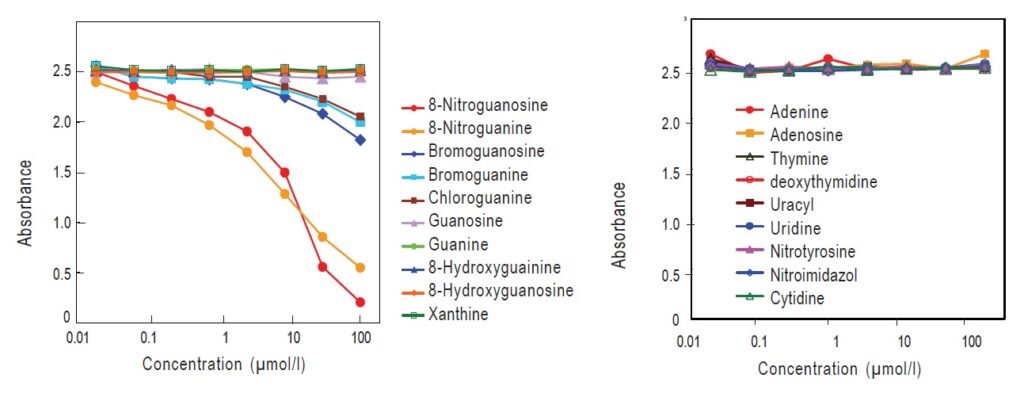Anti-Nitroguanosine monoclonal antibody(Clone#NO2G52)
DNA Damage Detection Antibody
-
Product codeAB02 Anti-Nitroguanosine monoclonal antibody(Clone#NO2G52)
-
Chemical nameMonOclonal anti-nitroguanosine antibody
| Unit size | Price | Item Code |
|---|---|---|
| 50 μg | $897.00 | AB02-10 |
Description
8-Nitroguanosine is a nitrated base of DNA and RNA. It is formed by peroxynitrite, which is generated from nitric oxide and superoxide anion radical. It is known that a large amount of nitric oxide molecules and superoxide anion, generated by inflammation, causes nitration of guanosine. Since chemically modified nucleotides cause mutation during DNA replication, 8-nitroguanosine is thought to be one of the markers of DNA damage related to mutation and cancer. Because of its very high specificity, monoclonal antibody NO2G52 recognizes 8-nitroguanine and 8-nitroguanosine, but it does not cross-react with normal nucleotide bases, 8-hydroxyguanine, 8-hydroxydeoxyguanosine, 3-nitrotyrosine, xanthine, or 2-nitroimidazole (Fig. 1). The specificity of NO2G52 was determined by a competitive ELISA using an 8-nitroguanosine-BSA-coated plate. As shown in the figures below, NO2G52 has very high affinity for 8-nitroguanine and 8-nitroguanosine, and it slightly cross-reacts with 8-bromoguanosine, 8-bromoguanine, and 8-chloroguanine. Anti-Nitroguanosine polyclonal antibody also recognizes 8-nitroguanine and 8-nitroguanosine, but it does not cross-react with normal guanosine, guanine, 8-hydroxyguanine, or 3-nitrotyrosine. Since this antibody was prepared using rabbits, it can be used for immuno-histostaining of rodent tissues such as mice or rats.

Fig 1. Specificity of Anti 8-Nitroguanosine monoclonal antibody
References
1) T. Akaike, S. Okamoto, T. Sawa, J. Yoshitake, F. Tamura, K. Ichimori, K. Miyazaki, K. Sasamoto and H. Maeda, "8-nitroguanosine formation in viral pneumonia and its implication for pathogenesis", Proc. Natl. Acad. Sci. USA, 2003, 100, 685.
2) J. Yoshitake, T. Akaike, T. Akuta, F. Tamura, T. Ogura, H. Esumi and H. Maeda, "Nitric oxide as an endogenous mutagen for Sendai virus without antiviral activity", J. Virol., 2004, 78, 8709.
3) T. Sawa, M. H. Zaki, T. Okamoto, T. Akuta, Y. Tokutomi, S. Kim-Mitsuyama, H. Ihara, A. Kobayashi, M. Yamamoto, S. Fujii, H. Arimoto and T. Akaike, "Protein S-guanylation by the biological signal 8-nitroguanosine 3',5'-cyclic monophosphate", Nat. Chem. Biol., 2007, 3, 727.
4) M. H. Zaki, S. Fujii, T. Okamoto, S. Islam, S. Khan, K. A. Ahmed, T. Sawa and T. Akaike, "Cytoprotective function of heme oxygenase 1 induced by a nitrated cyclic nucleotide formed during murine salmonellosis", J. Immunol., 2009, 182, 3746.
5) Y. Terasaki, T. Akuta, M. Terasaki, T. Sawa, T. Mori, T. Okamoto, M. Ozaki, M. Takeya and T. Akaike, "Guanine nitration in idiopathic pulmonary fibrosis and its implication for carcinogenesis", Am. J. Respir. Crit. Care. Med., 2006, 174, 665.
6) T. Sawa, M. Tatemichi, T. Akaike, A. Barbin and H. Ohshima, " Analysis of urinary 8-nitroguanine, a marker of nitrative nucleic acid damage, by high-performance liquid chromatography-electrochemical detection coupled with immunoaffinity purification: association with cigarette smoking", Free Radic. Biol. Med., 2006, 40, 711.
7) M. Feelisch, "Nitrated cyclic GMP as a new cellular signal", Nat. Chem. Biol., 2007, 3, 687.
8) K. A. Ahmed, T. Sawa and T. Akaike, "Protein cysteine S-guanylation and electrophilic signal transduction by endogeneous nitro-nucleotides", Amino Acids, 2011, 41(1), 123.
9) T. Sawa, H. Arimoto and T. Akaike, "Regulation of redox signaling involving chemical conjugation of protein thiols by nitric oxide and electrophiles", Bioconjugate Chem., 2010, 21(7), 1121
Handling and storage condition
| Appearance: | Colorless to pale yellow slightly turbid liquid |
|---|---|
| Antibody titer: | To pass test |
| -20°C |








